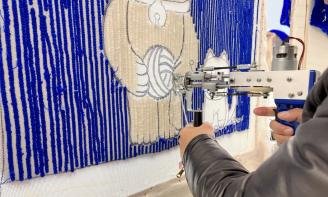Fazer tapetes com técnica de tufting se torna nova febre entre os jovens chineses, mas será que vai durar?

O proprietário de um estúdio de fielagem em Pequim demonstra como usar uma pistola de fielagem.
Foto: Lou Kang/GT

Um tapete do Bing Dwen Dwen Foto: Lou Kang/GT
Comprar uma pistola de tufting para fazer esteiras e tapetes DIY tornou-se extremamente popular entre os jovens chineses hoje devido ao senso de realização que ela traz. No entanto, donos de lojas dizem que o futuro desse hobby ainda está no ar, pois muitos clientes estão apenas "saltando no trem da moda" da última tendência.
Além das salas de fuga e experiências de mistério de assassinato, o tufting está se tornando uma nova maneira para os jovens passarem o tempo juntos durante o fim de semana em todo o país. Uma das formas mais rápidas de fazer tapetes, as pistolas de tufting existem há décadas. Com elas, tudo o que você precisa são algumas mechas de lã e um pedaço de tecido para fazer um tapete artesanal para si mesmo.
A partir da segunda metade de 2021, estúdios de tufting começaram a surgir em todo o país. Tomemos Xangai como exemplo, um total de 279 estúdios estão na plataforma online Dazhong Dianping, e 400 podem ser encontrados em Pequim também.
"Quando eu soube sobre essa indústria pela primeira vez em dezembro de 2021, havia apenas três estúdios no total no distrito de Chaoyang, em Pequim, mas agora mais de 10 estúdios, incluindo o meu, abriram a menos de 100 metros de distância uns dos outros", disse Song, dono de uma loja de tufting que opera um estúdio em um edifício de escritórios no distrito de Chaoyang, na capital, ao Global Times no sábado.
Chegada rápida, partida rápida
No contexto da pandemia de COVID-19, essa arte manual ganhou popularidade em todo o mundo desde o final de 2020, quando muitos artistas e blogueiros compartilharam vídeos de tufting nas redes sociais enquanto estavam em casa. A textura macia e as cores vibrantes dos tapetes foram um raio de sol para muitas pessoas tentando se adaptar à nova normalidade pandêmica.
Essa tendência foi posteriormente introduzida na China à medida que influenciadores começaram a compartilhar seus trabalhos feitos à mão nas redes sociais chinesas. Em pouco tempo, esse hobby acabou dando origem a uma nova indústria em expansão. Normalmente, um estúdio fornecerá todas as ferramentas e materiais necessários, desde pistolas de felpa e diferentes cores de lã até a tela, e os últimos passos de fixação inferior e vedação das bordas também são concluídos pela equipe nos estúdios, então tudo o que os clientes precisam fazer é se concentrar em criar seus padrões favoritos.
"Pode ficar realmente lotado de clientes, especialmente nos fins de semana, quando precisamos manter a porta aberta das 11 da manhã até meia-noite, esperando todos os nossos clientes terminarem seu trabalho", disse outro dono de loja em Pequim, sobrenome Yu, que administra um estúdio chamado Wool Lab, ao Global Times na segunda-feira.
Yu abriu seu estúdio com seus sócios há dois meses e já conseguiu pagar os custos do investimento devido à rápida ascensão da indústria.
As etapas são simples. O estúdio fornece um projetor para projetar o padrão escolhido pelos clientes em uma tela. Após o padrão ser traçado com um pincel, os clientes podem seguir o padrão com uma pistola de flocagem. Todo o processo criativo não requer nenhum conhecimento técnico e, como é fácil aplicar designs decorativos, como pinturas famosas, em outras coisas, como uma bolsa de mão. Portanto, tornou-se uma tendência quente em um curto período de tempo nos últimos cinco meses.
No entanto, apesar da onda atual de sucesso, muitos especialistas do setor têm dúvidas sobre quanto tempo essa tendência impulsionada por celebridades da internet durará antes de se tornar algo do passado.
Song disse que normalmente leva pelo menos cinco horas e custa entre 300 e 800 yuans ($47 a $125) para concluir uma obra, dependendo do seu tamanho e da complexidade do padrão, embora "não haja limite de escopo."
"E também esta é realmente uma atividade muito cansativa, exigindo o uso constante da pistola de flocagem. Acontece o tempo todo que os clientes não conseguem terminar seu trabalho depois de passar o dia inteiro no estúdio."
Quanto aos negócios repetidos, "alguns clientes vêm ao nosso lugar porque realmente gostam deste tipo de artesanato, mas quanto aos demais, eles apenas embarcaram na moda, deram uma chance e não voltarão para tentar novamente", acrescentou Song.
"Embora o custo de abrir um estúdio como este seja relativamente baixo, como cada sessão leva muito tempo, recebemos apenas um número limitado de clientes por semana... E não sabemos por quanto tempo essa tendência continuará."
Trazendo a bordado de volta
As pessoas na China sempre tiveram um grande amor pelo bordado. Por volta do início do século, o ponto cruz chinês (shizixiu) se tornou uma enorme febre e quase todas as casas compravam itens de artesanato bordados. Alguns dos padrões mais sofisticados podiam custar mais de 10.000 yuans.
Embora esse hobby, que era muito demorado e exigia o uso de agulhas pequenas, tenha diminuído em popularidade com o surgimento da moda rápida e o desenvolvimento de smartphones e internet móvel, a conveniência rápida trazida pelas espingardas de tufting trouxe-o de volta.
"Em comparação com a tradicional bordado que a China abraçou por séculos, o qual tem um requisito de entrada alto e exige dedicação ao longo de muito tempo, o baixo limite de entrada do tufting e seus resultados rápidos atendem justamente às necessidades de muitas pessoas que buscam felicidade instantânea nos dias de hoje", notou um especialista em bordado, acrescentando que essa tendência pode ser vista como benéfica, pois inspirou mais pessoas na sociedade a quererem aprender mais sobre bordado.

 EN
EN









































 ONLINE
ONLINE